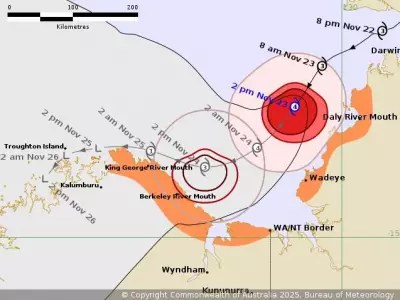
The night sky over the Illawarra and South Coast regions transformed into a breathtaking canvas of dancing lights on Wednesday, November 12, as the aurora australis put on a spectacular show that left observers in awe.
Electric Atmosphere as Southern Lights Dance
The mood was electric as people gathered with cameras and phones, their eyes trained upward in wonder. The southern lights, known scientifically as aurora australis, painted the darkness with majestic displays of pink, yellow, and purple hues, prompting many residents to rush outdoors to capture the rare phenomenon.
South Coast photographer Belinda Doyle was among those who captured stunning images during the display. "There were only a handful of people around, but everyone I spoke to was buzzing with excitement," she recalled. She took her photographs at the northern end of Seven Mile Beach in Gerroa between 8:30 PM and 9:45 PM.
"Honestly, it felt like a core memory for anyone lucky enough to witness it; it was spectacular," Ms Doyle expressed. "What a time to be alive, stars were captured, memories were made."
Northern Illawarra Also Gets a Show
The celestial display wasn't limited to the southern parts of the region. Anthony Turner headed to Austinmer and Thirroul in the northern Illawarra just before 9 PM to photograph the aurora.
"I noticed a slight pink-red glow looking out to sea," Mr Turner observed. He noted that "iPhone photos definitely showed up the beautiful colours a lot better" than what was visible to the naked eye.
How to Capture the Elusive Aurora
According to Ms Doyle, to the naked eye, the aurora appeared as soft, mist-like formations. However, the colour truly came to life through camera lenses. "The easiest way I've found to photograph the aurora is actually on a smartphone," she advised.
She recommended using night mode on smartphones and suggested a tripod for those with unsteady hands. For her own images captured on Wednesday night, she used a Canon mirrorless camera, acknowledging this method requires more skill.
"You really need to let in as much light as possible with a long exposure, and a tripod is essential. It's definitely outside my usual expertise, but the conditions couldn't have been more perfect," she explained.
The Science Behind the Spectacle
Auroras are geomagnetic storms that begin with events on the sun. They occur when coronal mass ejections - high-energy plasma clouds - escape the sun's gravitational field and travel toward Earth at speeds up to 3000 kilometres per second.
The Bureau of Meteorology explains that the brightest auroras concentrate in rings called auroral ovals around the north or south poles. While the northern hemisphere phenomenon is known as aurora borealis or northern lights, the southern version is called aurora australis.
This remarkable display on November 12 provided Illawarra and South Coast residents with a rare opportunity to witness one of nature's most magnificent light shows, creating memories that will last a lifetime for those fortunate enough to experience it.





